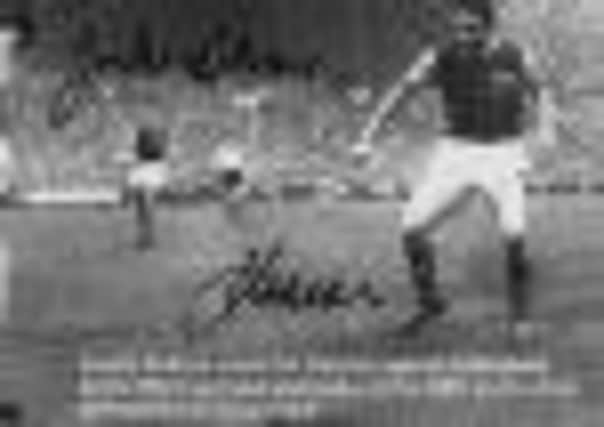Former Clarets to honour Burnley legend Jerry Dawson’s achievements


The Cliviger residents will join local children in the village, where Dawson was born, to unveil a blue plaque in his memory at Mount Lane at noon, on the wall of what will be known as the Jerry Dawson Pavilion.
And the ceremony takes on more poignancy in a week where the club lost a great in former captain and manager Jimmy Adamson.
Advertisement
Hide AdAdvertisement
Hide AdA minute’s silence will be observed before the plaque is unveiled, in honour of Adamson.
Visitors travelling by car to the ceremony are requested to make sure their vehicles are not obstructing the narrow lane alongside the ground and pavilion.
A photograph (pictured) of Jimmy Robson scoring Burnley’s goal at Wembley in the 1962 FA Cup Final, signed by Robson, John Connelly and Jimmy McIlroy, will be raffled in aid of Fulledge Colts who use Mount Lane as their home ground.
Here, Ray Simpson,
Burnley FC Historian and Archivist, tells Dawson’s story.
THE Burnley career of Jeremiah Dawson began in Edwardian times and lasted more than two decades before he played his final league match in 1928 at the age of 40.
Advertisement
Hide AdAdvertisement
Hide AdBy that time he had appeared in more competitive games for Burnley than any other player in the club’s history, won a League Championship medal, represented his country and selflessly stood aside as the Clarets triumphed in the FA Cup final of 1914.
Dawson was born in Clifton Terrace, Cliviger in 1888 and first played football for nearby Portsmouth Rovers while serving his apprenticeship with the village blacksmith. His ability between the posts soon brought the Turf Moor scouts along, and, after a few games in the reserves, he signed as a professional in February 1907.
Dawson was the model of consistency, brilliant when necessary with a presence that inspired confidence throughout the rest of his defence.
Few would argue that his arrival at Turf Moor sparked the dawn of a new era for a club then very much in the doldrums.
Advertisement
Hide AdAdvertisement
Hide AdIn February 1910, after almost three years as an automatic choice in Burnley’s Second Division side, Dawson was selected to represent the Football League against the Scottish League at Ewood Park and, although he Scots edged home 3-2, he had made his mark.
In the return match at Ibrox in March 1911 he produced a masterful display, and, at the end of a pulsating 1-1 draw, the Scottish crowd rose as one to applaud the man from Cliviger off the field.
Back at Turf Moor, in 1913, after a dozen years out of the top flight, Burnley regained their First Division place and reached the FA Cup semi-final for the first time only to lose narrowly to Sunderland.
Then, in 1914, came the peak of Burnley’s achievement thus far when the FA Cup came to Turf Moor. It was however a time of contrasting emotions for Dawson who performed immaculately to the semi-final stage where he was injured in the goalless draw against Sheffield United at Old Trafford. His deputy Ronnie Sewell took over for the Goodison Park replay and gave a solid display in a 1-0 win.
Advertisement
Hide AdAdvertisement
Hide AdA week before the final Dawson suffered another injury and, after agonising on his fitness, decided not to risk letting the team down and stood aside. Sewell was beckoned onto centre stage for the all-Lancashire final against Liverpool, the last ever at the Crystal Palace Stadium.
A dour struggle ended 1-0 to the Clarets with a Bert Freeman goal deciding the destiny of the famous old trophy. Uniquely, all the Burnley medals were inscribed “English Cup Winners” and, two weeks after the final, Dawson himself was presented with a special medal requested by the Burnley committee and sanctioned by the Football Association.
After the First World War Dawson was still Burnley’s first choice between the sticks as the Clarets served notice of more great times ahead, finishing as First Division runners-up to West Bromwich Albion in 1920.
In 1920-21, Burnley swept to the League Championship for the first time, establishing the phenomenal record during that campaign of 30 league games without defeat.
Advertisement
Hide AdAdvertisement
Hide AdThree Burnley players appeared in all thirty of those historic games, Billy Watson, Billy Nesbitt and Dawson himself but he was injured for the final match of the most magnificent season in the club’s history.
Dawson’s long-awaited England debut came in October 1921 in a 1-1 draw with Ireland in Belfast and he won just one other full international cap. At 34 he was just past his prime and, as well as losing four of his peak years because of the Great War, also had as his contemporary arguably the greatest England goalkeeper ever, Sam Hardy, as competition.
He was still Burnley’s first choice, almost automatically so, until 1926 by then having established a new league appearance record for the club. Eventually he decided enough was enough and played his 569th and final first team game in front of the Turf Moor faithful on Christmas Day 1928. It was nine months after he celebrated his 40th birthday and almost 22 years after first signing for Burnley, his only club. He was, and still is, the oldest player ever to appear in a competitive senior match for Burnley FC.
He joined the Turf Moor coaching staff and also kept himself fit playing cricket for Burnley CC. He was an accomplished batsman and graced the Lancashire League scene for many years.
A lifelong bachelor, Jerry Dawson lived in Cliviger all his days and died at his home on August 8th, 1970, aged 82. He was buried in St John’s churchyard in the village.